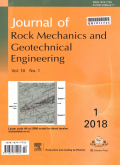- 钛学术文献服务平台 \
- 学术期刊 \
- 基础科学期刊 \
- 天文学、地球科学期刊 \
- 岩石力学与岩土工程学报(英文版)期刊 \
Effect of natural and synthetic fibers reinforcement on California bearing ratio and tensile strength of clay
Effect of natural and synthetic fibers reinforcement on California bearing ratio and tensile strength of clay
基本信息来源于合作网站,原文需代理用户跳转至来源网站获取
摘要:
Use of environmentally friendly approaches with the purpose of strengthening soil layers along with finding correlations between the mechanical characteristics of fiber-reinforced soils such as indirect tensile strength (ITS) and California bearing ratio (CBR) and as well as the evaluation of shear strength parameters obtained from the triaxial test would be very effective at geotechnical construction sites. This research was aimed at investigating the influence of natural fibers as sustainable ones including basalt (BS) and bagasse (BG) as well as synthetic polyester (PET) fibers on the strength behavior of clayey soil. To this end, the effects of various fiber contents (0.5%, 1%and 2%) and lengths (2.5 mm, 5 mm and 7.5 mm) were experimentally evaluated. By conducting ITS and CBR tests, it was found that increasing fiber content and length had a significant influence on CBR and ITS values. Moreover, 2%of 7.5 mm-long fibers led to the largest values of CBR and ITS. The CBR values of soil reinforced with PET, BS, and BG fibers were determined as 19.17%, 15.43%and 13.16%, respectively. The ITS values of specimens reinforced with PET, BS, and BG fibers were reported as 48.57 kPa, 60.7 kPa and 47.48 kPa, respectively. The results of the triaxial compression test revealed that with the addition of BS fibers, the internal friction angle increased by about 100%, and with the addition of PET fibers, the cohesion increased by about 70%. Moreover, scanning electron microscope (SEM) analysis was employed to confirm the findings. The relationship between CBR and ITS values, obtained via statistical analysis and used for the optimum design of road pavement layers, demonstrated that these parameters had high correlation coefficients. The outcomes of multiple linear regression and sensitivity analysis also confirmed that the fiber content had a greater effect on CBR and ITS values than fiber length.

推荐文章
The effects of clay minerals and organic matter on nanoscale pores in Lower Paleozoic shale gas rese
Nanoscale pore
Clay minerals
Organic matter
OM–clay composites
Pore distribution characteristics
Pore connectivity
A combined IR and XRD study of natural well crystalline goethites(α-FeOOH)
Crystallinity
Goethite
IR-spectrometry
X-ray diffraction
XRD rietveld refinement
Characterization
Adobe After Effect插件原理及其实现
插件
PICA
COM
基于GPU实现SlideShow中的effect和transition
图像处理器
Direct3D
SlideShow
固定功能流水线
可编程流水线
高级渲染语言
顶点渲染
像素渲染
内容分析
关键词云
关键词热度
相关文献总数
(/次)
(/年)
文献信息
| 篇名 | Effect of natural and synthetic fibers reinforcement on California bearing ratio and tensile strength of clay | ||
| 来源期刊 | 岩石力学与岩土工程学报(英文版) | 学科 | |
| 关键词 | |||
| 年,卷(期) | 2021,(3) | 所属期刊栏目 | |
| 研究方向 | 页码范围 | 626-642 | |
| 页数 | 17页 | 分类号 | |
| 字数 | 语种 | 英文 | |
| DOI | |||
五维指标
引文网络
引文网络
二级参考文献 (16)
共引文献 (7)
参考文献 (22)
节点文献
引证文献 (0)
同被引文献 (0)
二级引证文献 (0)
1992(1)
- 参考文献(0)
- 二级参考文献(1)
1996(1)
- 参考文献(0)
- 二级参考文献(1)
1998(1)
- 参考文献(0)
- 二级参考文献(1)
2003(2)
- 参考文献(1)
- 二级参考文献(1)
2004(1)
- 参考文献(0)
- 二级参考文献(1)
2005(2)
- 参考文献(0)
- 二级参考文献(2)
2006(1)
- 参考文献(0)
- 二级参考文献(1)
2008(1)
- 参考文献(1)
- 二级参考文献(0)
2010(2)
- 参考文献(0)
- 二级参考文献(2)
2011(4)
- 参考文献(1)
- 二级参考文献(3)
2012(4)
- 参考文献(1)
- 二级参考文献(3)
2014(2)
- 参考文献(2)
- 二级参考文献(0)
2015(2)
- 参考文献(2)
- 二级参考文献(0)
2016(2)
- 参考文献(2)
- 二级参考文献(0)
2017(5)
- 参考文献(5)
- 二级参考文献(0)
2018(2)
- 参考文献(2)
- 二级参考文献(0)
2019(5)
- 参考文献(5)
- 二级参考文献(0)
2021(0)
- 参考文献(0)
- 二级参考文献(0)
- 引证文献(0)
- 二级引证文献(0)
引文网络交叉学科
相关学者/机构
期刊影响力
岩石力学与岩土工程学报(英文版)
主办单位:
中国科学院武汉岩土力学所
中国岩石力学与工程学会
武汉大学
出版周期:
双月刊
ISSN:
1674-7755
CN:
42-1801/O3
开本:
大16开
出版地:
湖北省武汉市武昌区水果湖街小洪山2号
邮发代号:
38-299
创刊时间:
2009
语种:
eng
出版文献量(篇)
931
总下载数(次)
0
总被引数(次)
2844
期刊文献
相关文献
推荐文献
- 期刊分类
- 期刊(年)
- 期刊(期)
- 期刊推荐
力学
化学
地球物理学
地质学
基础科学综合
大学学报
天文学
天文学、地球科学
数学
气象学
海洋学
物理学
生物学
生物科学
自然地理学和测绘学
自然科学总论
自然科学理论与方法
资源科学
非线性科学与系统科学
岩石力学与岩土工程学报(英文版)2022
岩石力学与岩土工程学报(英文版)2021
岩石力学与岩土工程学报(英文版)2020
岩石力学与岩土工程学报(英文版)2019
岩石力学与岩土工程学报(英文版)2018
岩石力学与岩土工程学报(英文版)2017
岩石力学与岩土工程学报(英文版)2016
岩石力学与岩土工程学报(英文版)2015
岩石力学与岩土工程学报(英文版)2014
岩石力学与岩土工程学报(英文版)2013
岩石力学与岩土工程学报(英文版)2012
岩石力学与岩土工程学报(英文版)2011
岩石力学与岩土工程学报(英文版)2010
岩石力学与岩土工程学报(英文版)2009
岩石力学与岩土工程学报(英文版)2021年第5期
岩石力学与岩土工程学报(英文版)2021年第4期
岩石力学与岩土工程学报(英文版)2021年第3期
岩石力学与岩土工程学报(英文版)2021年第2期
岩石力学与岩土工程学报(英文版)2021年第1期

 免费查重
免费查重










